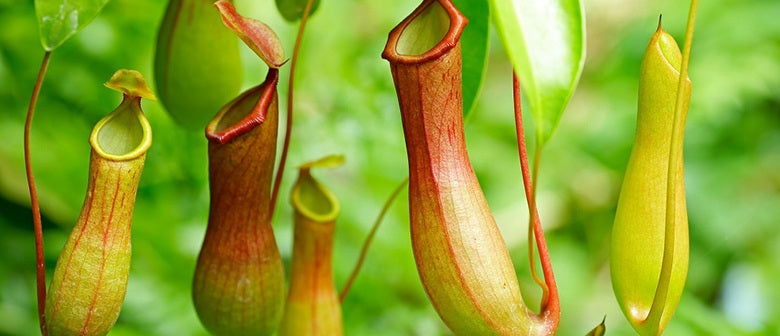A Guide to Carnivorous Plants
Carnivorous plants are fiercely fascinating in their ability to catch their own food. Carnivorous plants naturally grow in poor soil and take few nutrients from the ground. They’re an organic form of fly control which is very effective. Below we outline the most common carnivorous plants that we have instore over the summer months:
Venus Fly Trap
Probably the most well known carnivorous plant.
How they catch their prey
Small trigger hairs are extremely sensitive to touch, when these hairs are bent, the plant will close around the object that triggered it.
Closure takes place in two stages, the first closure is fast, but only part way to allow smaller, less nutritious insects to escape. If the right sized insect is captured, the finger like structures that line the top of the leaves lace together, eventually forming an air tight seal so that bacteria can’t get in and the digestive juices do not leak out. Over the next 5 to 12 days the insect is slowly digested, after which the fly trap will open again.
Care Guide
Venus flytraps need a lot of moisture, but too much water in the pot or in their soil can lead to mildew growth and root rot—so plant them in a spot with good drainage. They should be kept damp at all times, the best way to do this is to sit them in a dish or saucer and water them from the bottom.
Venus flytraps are used to growing in undernourished, acidic, and sandy soil. Do not use potting mix or compost and resist the urge to fertilise them as an overload of nutrients can be detrimental.
Venus flytraps can survive in partial shade and a minimum of 4 hours of sunlight, but if you want them to thrive, provide them with 12 hours of direct, bright sunlight. The morning is the best time for this since the rays are not too intense.
Venus flytraps bloom in Spring, grow through Summer and Autumn and usually enter dormancy in Winter (roughly 3-5 months). They do not die in the Winter, although it may look like they have. They just aren’t trying as hard to grow in order to conserve energy for the next growing season. This doesn’t mean you can neglect them, they still need sunlight and water to perform photosynthesis.
Sick, dying, or dead leaves and other plant parts are susceptible to fungal growth that can invade and kill the rest of the plant; it is important to remove them as soon as you notice them. It’s easy to tell if the leaves are dead or dying: they will be wilted, dry, and appear brown or black.
As tempting as it is, do not put your finger in a Venus Flytrap. It won’t harm you, but it will harm the plant as it will zap the plant’s energy by closing and then reopening a day or two later when it realises that there is nothing in its trap. A trap can only open and close a few times within its lifetime.
Nepenthes aka Pitcher Plant
One of the largest and probably the most ostentatious carnivorous plant, with over 170 species.
How they catch their prey
The Nepenthes employs a different, more passive strategy. Pitcher plants have modified leaves that act as traps. Sugary nectar secreted near the tip of the trap draw insects in towards the slippery inner wall and get trapped in the digestive juices.
Care Guide
Nepenthes grow spectacularly on sunny windowsills, but protect them from draughts, extreme heat or cold.
Avoid full shade – sun is the key element in getting your plant to grow pitchers. The energy provided by photosynthesis is what grows the traps, and the light from the sun is essential in producing good colour.
Make sure the water drains through the soil completely, lift the pot to make sure it’s heavy and saturated. Avoid standing water, as this can cause root rot and can make them susceptible to pests.
Avoid using potting mix and compost, as their nutrient and mineral ingredients can kill carnivorous plants.
Drosera aka Sundew
One of the largest genera of carnivorous plants, with nearly 200 species. Sundews are as weird and wonderful as carnivorous plants can get.
How they catch their prey
The tiny tentacle hairs, glisten like they’re tipped with dew, it is in fact a sticky, glue like substance that ensnares the prey in a deadly hug and then digests it.
Care Guide
Originally hailing from tropical climates, it’s best to keep them indoors on a sunny windowsill. Protect from wind, harsh sunlight and freezing temperatures. Avoid full shade.
Mineral free water is required for Sundews, if your tap water is relatively pure, you can water your plants with it. Distilled, rainwater or bottled water is another good option.
Keep the soil wet at all times, the best way to do this is to set your plant in small amounts of water.
Do not use potting mix, compost or fertiliser. Instead, opt for perlite and peat moss.




